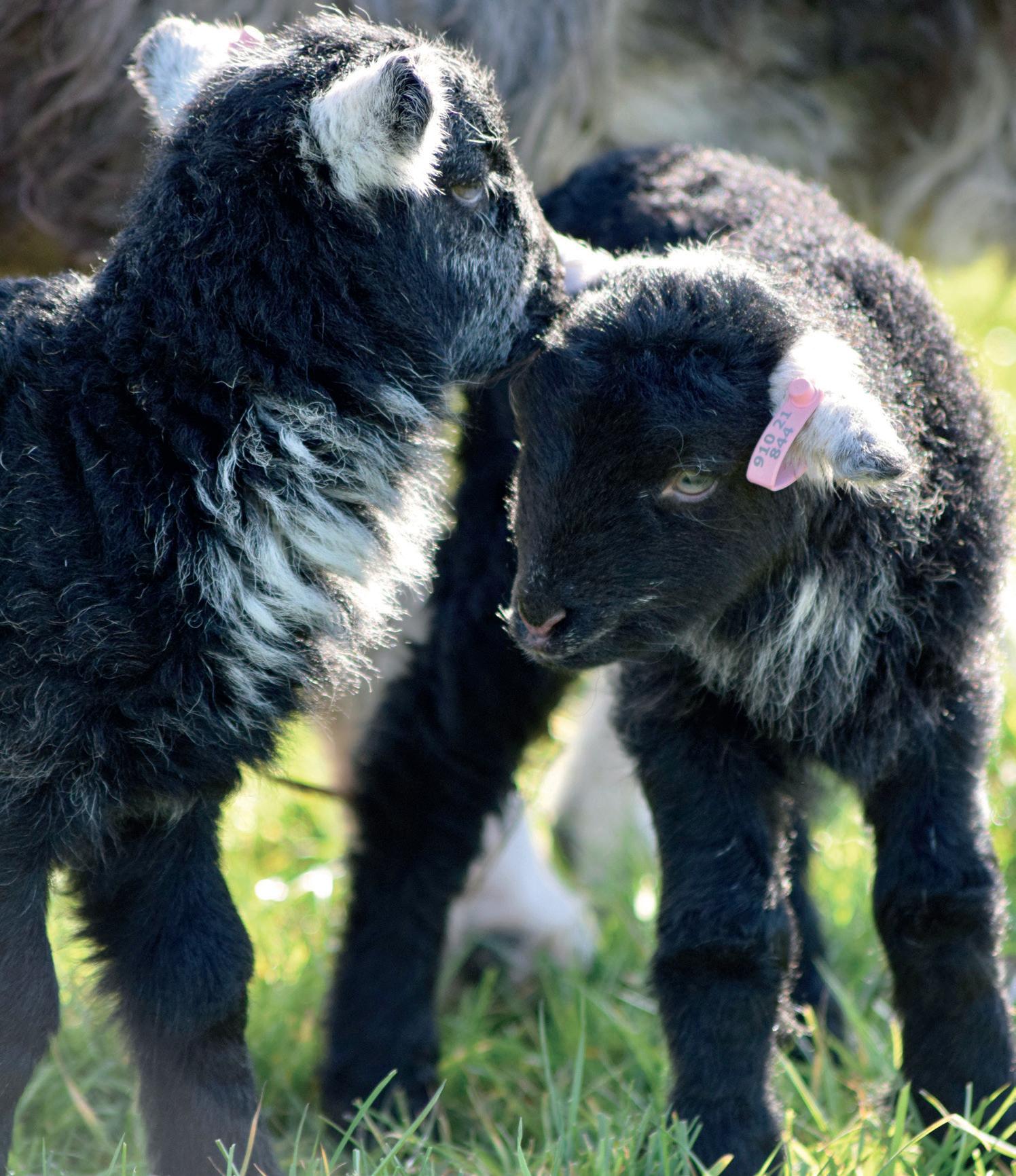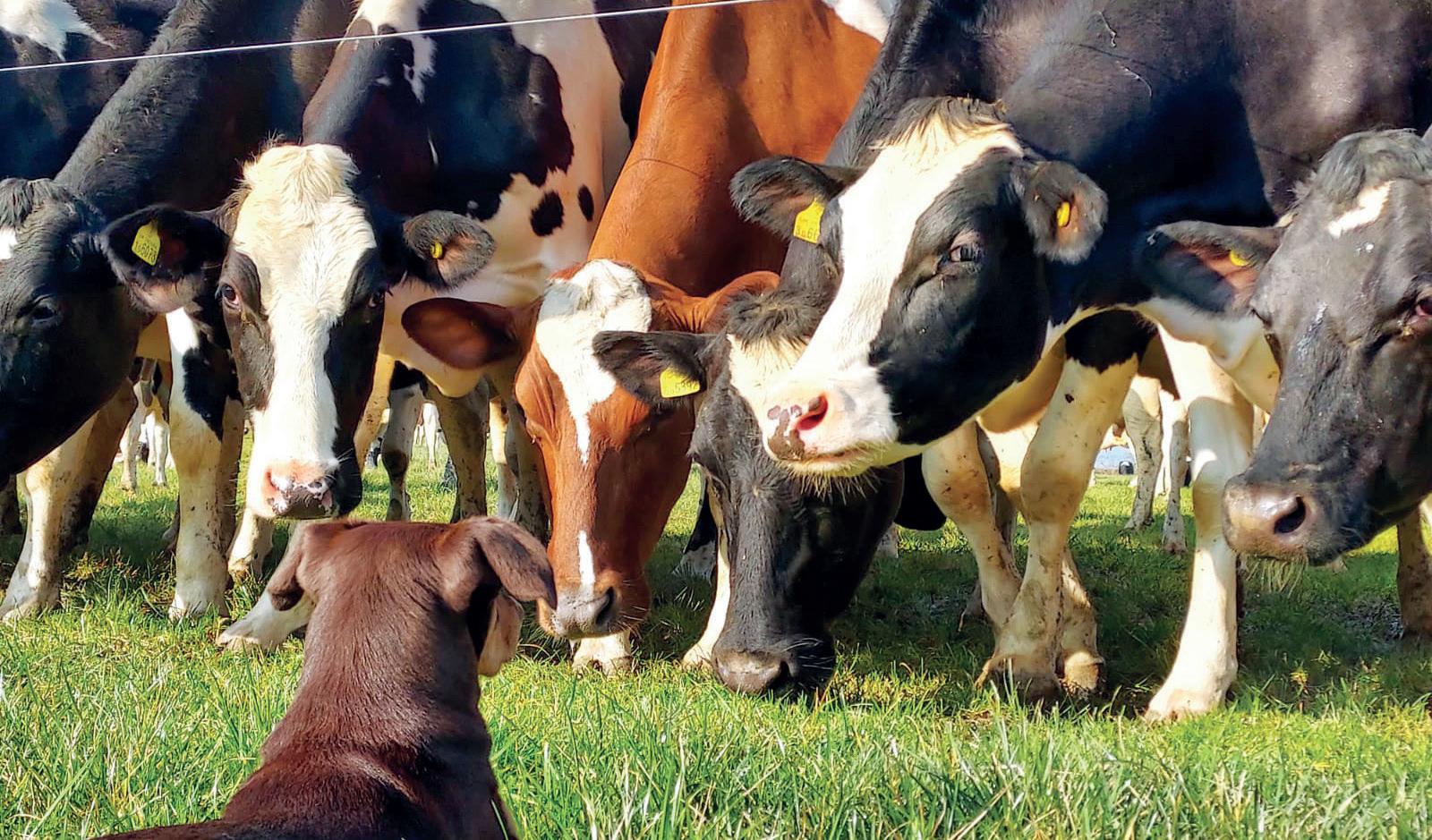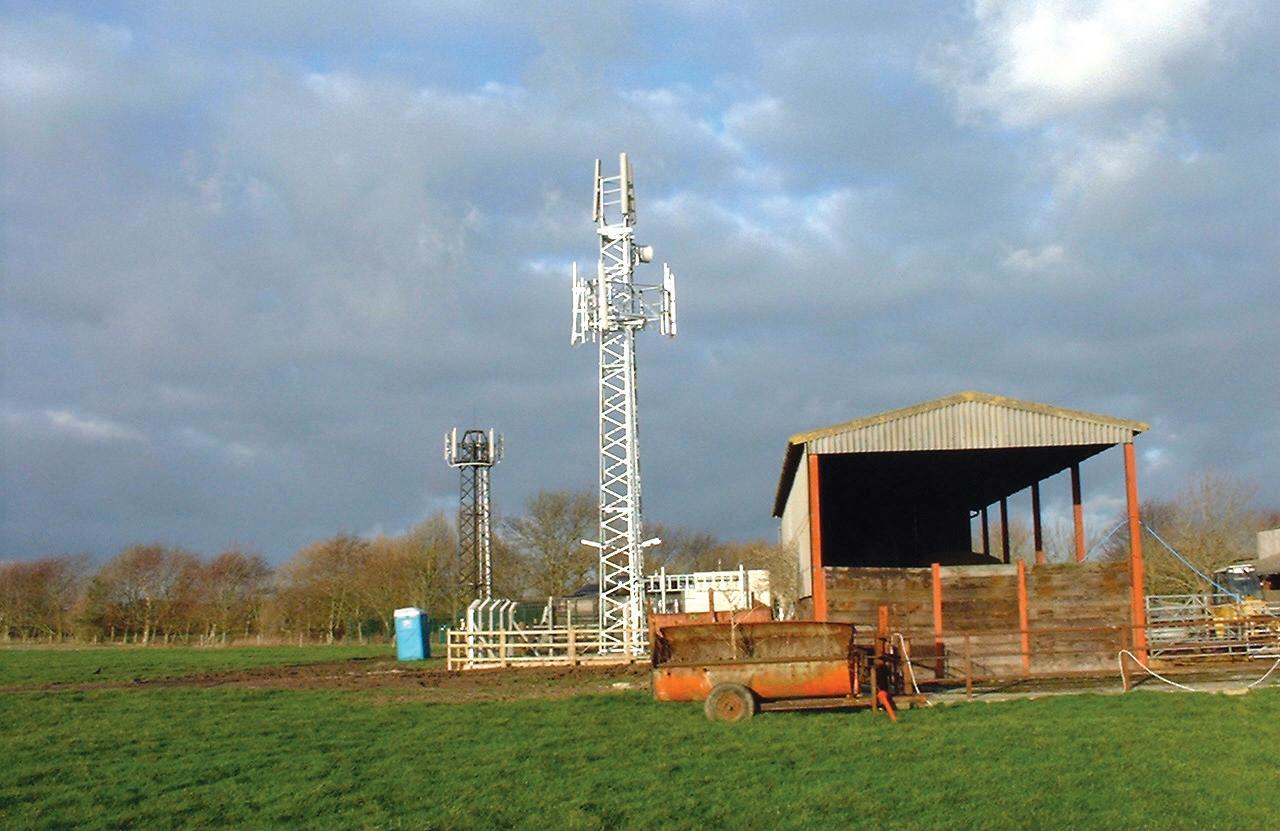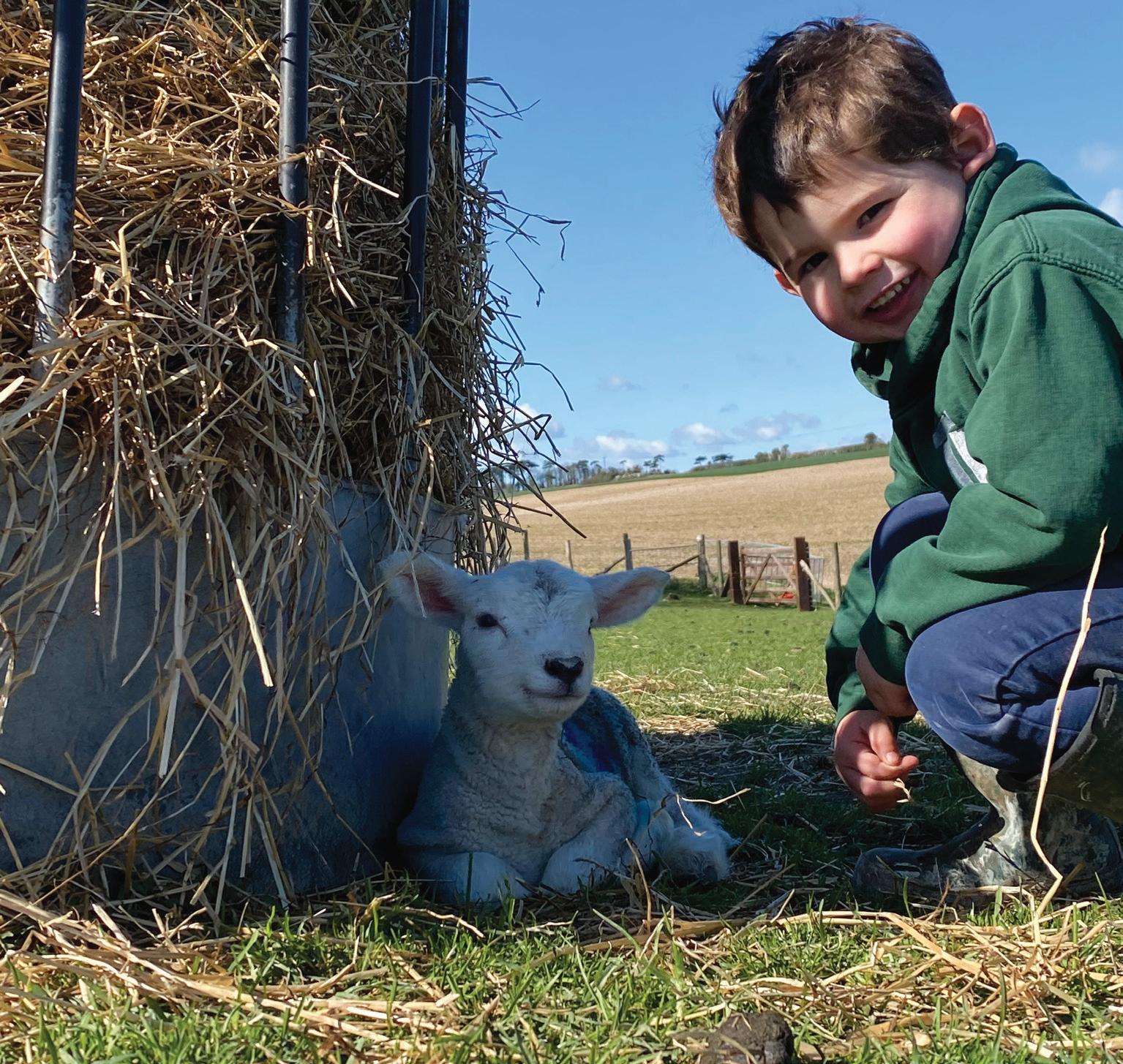
10 minute read
ALAN WEST


ALAN WEST Sheep farmer LAMBING DONE, NOW WHERE IS THE GRASS?
Well, once they fi nally decided to get on with it, everything was done and lambed within 18 days, start to fi nish, at least with the Lleyn. Some cracking lambs and all delivered with remarkable ease; my ideal lambing would be one in which I didn’t have to assist any ewes, a target that was almost achieved this year, with just one mal-presentation, an old girl who had a partial prolapse, so I was keeping a close eye on her; popped out her fi rst lamb no problem, then second water bag appeared with a tail, but with the problem quickly sorted she was tucked up in a mothering pen with a lovely pair of lambs in no time.
Sadly the prolapse problem does mean that it will be her last season with us; she has served us well and has provided 11 very good lambs in her fi ve lambings. This year’s crop of lambs have also, for me at least, seemed to be particularly robust when
> Herdwick, not the most productive of sheep, but what they do they do cheaply, and they certainly produce bonny lambs they were born. With good birth weights, very active lambs and good milky ewes they have got away very quickly, with very few mortalities and, I can honestly say, none that was in any way avoidable. I suspect that the use, for a number of years, of Lleyn Gold has played a signifi cant part and the criterion for selecting replacement ewes has really begun to show benefi ts. The system is based around the selection of good milky ewes and lambs with a high initial growth rate, as determined by eight week litter weights as a percentage of ewe weight at weaning; simple but very eff ective.
With better weather towards the end of March, everything was back out onto grass in no time; for some of those born in the evening, they were mothered up overnight, tagged and tailed the next morning and back out within 12 hours or so. And they have really benefi ted. There is nothing quite like a decent bite of good grass for putting milk under ewes and they have responded by milking incredibly well. One rather strong, foolhardy and cheeky ram lamb just happened to walk up to have a close look at me the other morning, within arm’s reach, so I scooped him up and popped him on the scales; born as one of a pair at 5.5kg he weighed a good 16.5kg at exactly four weeks old, an average daily gain of 393gm (0.87 lbs), with his twin brother looking almost as good. The boss’s small Herdwick fl ock, following on about a week after the main fl ock fi nished, was even more obliging, with all of them lambing within seven days and not a single bit of assistance required, although for a hill breed the latter is just what one would expect, thus providing a nice tidy end to lambing. Strangely, out of six Herdwick ewes producing eight lambs (133% lambing, not bad) the good lady had seven ewe lambs and only one ram. In 50+ years of working with sheep I have never previously encountered such an extreme ewe to ram ratio, albeit with a small number. Unfortunately, with so many ewe lambs, I can foresee a dramatic expansion of the Herdwick fl ock in two years time.
Being able to keep some paddocks clear of sheep for a little over four months from October until lambing has certainly paid off this year. The grass growth over that period has been suffi cient to sustain the ewes right through lambing, and even now in mid-April they still have a decent wedge in front of them. I know that winter grass reputedly has limited feed value, but it has done the girls well so far this season.
The problem is, where do we go from here? Grass growth, certainly on the few paddocks that were grazed further on into the winter, is remarkably slow to recover and the paddocks that have been grazed over lambing are not faring much better. This is not a problem that is limited to the South East, as communications with sheep keepers in other parts of the country have clearly indicated. Some areas are signifi cantly worse off than we are. This is in spite of the fact that I have deliberately avoided grazing too hard, leaving a good grass cover when sheep have been moved on to fresh paddocks in order to encourage a more rapid recovery, sadly with little apparent eff ect, but we will see. The unseasonably warm spell that we experienced a couple of weeks ago was just what was needed to kick start this season’s grass growth. At the time all of the grass perked up and began to grow, but a subsequent run of colder weather has eff ectively once again brought things to a standstill.
I hope that we are not going to suff er a repeat of the 2020 grass growing season; at the moment grass
growth is behind where it was at the same time last year, and with a snow shower while doing the sheep rounds this morning (12 April) and the fact that we have only had 7mm of rainfall since mid March, things are not looking too encouraging at present. That said, there is still plenty of time for things to turn around and, as a bonus, there is certainly no need to worry too much about fl y strike at the moment and, as yet, there are no Nematodirus warnings. But this does not provide any room for complacency, for the latter in particular, as a sudden warm spell after a run of colder weather can trigger a sudden and quite large rise in the threat from Nematodirus, so there is a need to be prepared. Unprepared, and without timely treatment, Nematodirus can kill lambs.
The real bonus at the moment is the high price of hoggets, which topped 307p/kg in Ashford Market last week and even topped 338p/kg in Bakewell. Tight supplies from domestic producers and from New Zealand, where producers are trying to rebuild stock numbers, have sustained almost unprecedentedly high prices since the New Year, signifi cantly better, I suspect, than ever anticipated. It is just what the industry needs to generate a bit of confi dence, and a decrease in the national fl ock size over the past year and the potential for a reduced lamb crop this year in parts of the country, due to adverse weather, could help to maintain fi rm prices for the rest of the year. I suspect that prices do need to come back a little so as not to erode demand, particularly within the catering sector as it begins to open up again after lockdown. It would be good to see British lamb on menus, but for a successful trade everyone in the chain needs to be able to make their margin.
Fingers crossed now for some good grass growing weather and for a continued good trade. It would be good, after the past two years, to see a season in which we can all produce a bit more off grass and to have a sensible market providing an adequate reward for all the hard work, and at times worry, that has gone into producing this year’s crop of lambs. That said, if I had the area (I gave up about a third of my grazing a couple of years ago due to persistent dog worrying issues) and resources I would certainly be looking to use a wider range of forage crops to provide an early spring bite, help fi ll the inevitable summer decline in grass growth and extend the grazing season further into the autumn/ winter as an insurance against unfavourable, and potentially rather extreme, weather patterns.
As it is, I am prepared for the strategic use of some creep feeding in the event of grass supplies tightening too much in order to keep lambs moving forward and, with an eye to next year’s lamb crop, take some of the pressure off the ewes. I really do not want them losing more body condition than I can sensibly get back on them between weaning and tupping this coming autumn. And so the cycle goes on.
As we fi nally welcome the return of the sun with a glimpse of social freedom and a pint, our farm vets are right smack bang in the middle of the action with the calving and lambing season upon us.
This inevitably means there will be some abortions. We have recently conducted a number of abortion investigations in sheep and cattle, the most recent of which was in a dairy herd which had experienced three abortions of four to fi ve month pregnancies in a period of a few weeks. A range of samples was taken from an aborted foetus and the results came back with a positive diagnosis for Neospora infection.
As many of you may be aware, Neospora caninum is a protozoan infection which can occur either from direct ingestion of the oocysts (parasite eggs) by the cattle or by acquiring it from dam to daughter through the placenta. Cattle infected will have an 80% to 90% chance of aborting or producing calves with a persistent Neospora infection.
Neospora is the most commonly attributed cause of abortion in cattle, and a three year study of 114 farms in south west England showed over 90% had at least one positive animal in that time. Another study of 500 dairy farms testing bulk milk tanks indicated a prevalence of 51%, much higher than initially thought.
Cattle pick up oocysts from dogs which have been exposed to Neospora mainly from infected aborted material. Dogs shed these oocysts in the faeces onto feed/fi elds/water courses where the cattle are exposed. The main risk of entry onto farm is through the purchase of infected cattle, and the greatest risk of spreading it within the herd is a farm dog with access to aborted material.
It is important to note there is little evidence that foxes or any other wildlife spread Neospora
VET DIARY ABORTION INVESTIGATIONS

oocysts. They can be infected, but studies have shown there is no conclusive evidence that they are important in terms of signifi cant spread. Further research will need to be done, but in the meantime, we should still consider them a low risk factor.
So how do we go about controlling Neosporosis in the herd? There are currently no treatments or vaccines available in the UK for this disease. Instead we have to implement some important management changes such as increasing biosecurity, disposing of afterbirth and restricting dog access to calving areas, cattle feed and water sources; and controlling rodent populations as they act as an intermediate host and may pose risk of infection to dogs.
Reducing dam to foetus infection is slightly trickier, but fi guring out which animals have been infected is important, so testing is essential. Then we can cull, or breed to beef in a dairy herd. It has been proved that Limousin foetuses have half the risk of abortion of a black and white calf, but breeding to any beef sire has been shown to reduce the risk of abortion and ensures you are not keeping breeding females to pass on infections. We should therefore only keep heifers from antibody negative dams.
Please speak to your vet to discuss any abortions and remember that any abortion should be reported to APHA for Brucellosis screening.
WILL JAMES
Cliff e Veterinary Group
T: 01273 473232 E: will@cliff evets.co.uk










